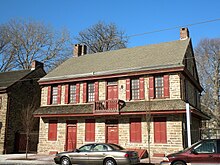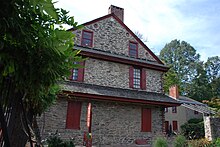Grumblethorpe
Grumblethorpe | |
 Grumblethorpe prior to its restoration in the 1960s, displaying its early 19th-century Georgian-style façade | |
| Location | 5267 Germantown Avenue, Germantown, Philadelphia, Pennsylvania, U.S. |
|---|---|
| Coordinates | 40°1′56″N 75°10′6″W / 40.03222°N 75.16833°W |
| Area | < 1-acre (4,000 m2) |
| Built | 1744 |
| Architectural style | American Georgian |
| NRHP reference No. | 72001155[1] |
| Added to NRHP | March 16, 1972 |
Grumblethorpe was the home of the Wister family in the present-day Germantown section of Philadelphia, who lived there for over 160 years. It was built in 1744 as a summer residence, but it became the family's year-round residence in 1793. It is a museum, part of the Colonial Germantown Historic District.
History[edit]
18th century[edit]


Grumblethorpe was built as a summer residence in 1744 by Philadelphia merchant and wine importer John Wister, when Germantown was a semi-rural area outside the city of Philadelphia. It eventually became the family's year-round residence when they withdrew from the city during the Yellow Fever Epidemic of 1793.
It has a stone and oak facade and was known as "John Wister's Big House". It has lower-ceilinged rooms than those at Cliveden, Loudoun, and Stenton, other historic houses in the area.[2] The stones for the house were quarried on the property and the joists were hewn from oaks in Wister Woods, also owned by the family. The original section of the Grumblethorpe Tenant House was built as a dependency.[clarification needed]
The Wister family lived in the house for over 160 years. Diarist Sally Wister subsequently lived there from 1789 until her death in 1804.[3]
Because it was built on the fertile soil of the region, Grumblethorpe's garden was highly productive. It was primarily a working farm, and it dominated Philadelphia's horticultural trends for nearly two centuries from 1740 to 1910. The land was a prime source of marketable crops and animal husbandry from the 1740s to the 1870s, and it decreased in practical use only when the farmstead grew smaller in the late 19th century.[4]
American Revolutionary War[edit]
In September 1777, the house was the scene of events in the Battle of Germantown. While the Wisters were staying in another home, British General James Agnew occupied the house as his headquarters during the battle. He was wounded and died in the front parlor, where his blood stains can still be seen on the floor.[5]
20th century[edit]
In the 1960s, the house was restored and refurnished to match the original period, removing an early 19th-century Georgian-style façade, and now serves as a museum. The gardens are also being restored.
Grumblethorpe was listed on the National Register of Historic Places in 1972. It is a contributing property of the Colonial Germantown Historic District, which has been designated a National Historic Landmark.
See also[edit]
National Register of Historic Places listings in Northwest Philadelphia
References[edit]
- ^ "National Register Information System". National Register of Historic Places. National Park Service. January 23, 2007.
- ^ "Grumblethorpe". U.S.history.org. Retrieved October 4, 2015.
- ^ Albert Cook Myers, ed. Introduction, Sally Wister's Journal: A True Narrative: Being a Quaker Maiden's Account of Her Experiences with Officers of the Continental Army, 1777-1779. Ferris & Leach, Philadelphia, 1902.
- ^ Susanin, Jay Davidson (May 28, 1990). "Grumblethorpe : an historic landscape report". Retrieved May 28, 2021 – via Internet Archive.
- ^ Moss, Roger W. (1998). Historic Houses of Philadelphia: A Tour of the Region's Museum Homes. University of Pennsylvania Press. p. 142. ISBN 978-0812234381.
Further reading[edit]
- Minardi, Joseph M. Historic Architecture in Northwest Philadelphia: 1690-1930s. Atglen, PA: Schiffer Publishing, 2011.
- H.D. Eberlein and H.M. Lippincott, The Colonial Homes of Philadelphia and Its Neighbourhood, J.B. Lippincott Co., Phila. and London, 1912.
- Roger W. Moss, Historic Houses of Philadelphia: A Tour of the Region's Museum Homes, University of Pennsylvania Press, 1998.
- John L. Cotter, Daniel G. Roberts, and Michael Parrington, The Buried Past: An Archaeological History of Philadelphia, University of Pennsylvania Press, 1992.
External links[edit]
- Official Grumblethorpe page at Philadelphia Society for the Preservation of Landmarks website
- Historic American Buildings Survey (HABS) No. PA-7-1, "Grumblethorpe", 6 photos, 11 measured drawings, 5 data pages, 1 photo caption page
- HABS No. PA-7-6, "Grumblethorpe Tenant House", 4 photos, 10 measured drawings, 1 data page, 1 photo caption page
- Grumblethorpe data from the Philadelphia Architects and Buildings (PAB) project of the Athenaeum of Philadelphia
- Painting of Grumblethorpe
- American Revolutionary War museums in Pennsylvania
- Historic American Buildings Survey in Philadelphia
- Historic district contributing properties in Pennsylvania
- Historic house museums in Philadelphia
- Houses completed in 1744
- Houses on the National Register of Historic Places in Philadelphia
- Georgian architecture in Pennsylvania
- Germantown, Philadelphia
- Wister, Philadelphia
- 1744 establishments in the Thirteen Colonies
- Wister family
- Historic House Museums of the Pennsylvania Germans





